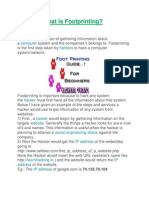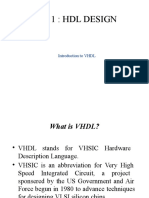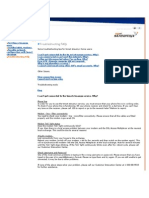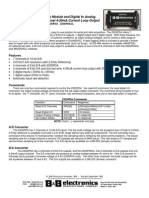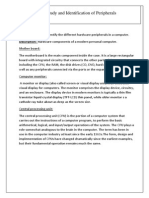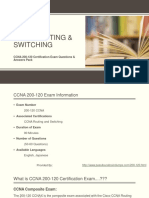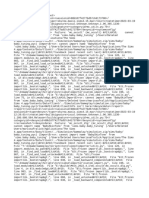Oracle XML Publisher Training Document
Uploaded by
Anonymous 9RtstMxlTOracle XML Publisher Training Document
Uploaded by
Anonymous 9RtstMxlTOracle XML Publisher Training Document
Raju Ch
An Insider Guide to XML Publisher
Oracle XML Publisher has gained a lot of popularity among developers and also among the
businesses as its very easy to create a report using XML Publisher and even more easy to
generate reports in various formats like PDF, EXCEL, RTF etc.
XML Publisher
Oracle XML Publisher has gained a lot of popularity among developers and also among the businesses as
its very easy to create a report using XML Publisher and even more easy to generate reports in various
formats like PDF, EXCEL, RTF etc.
Oracle created XML Publisher is as a template based tool for publishing reports and much more along
with Oracle E-business Suite. XML Publisher is powerful enough to populate the data fetched by a PL
SQL package into a custom, yes custom, template and then generate the report in any of the desired form
such as PDF, HTML, RTF, EXCEL (HTML) and even PLAIN TEXT for transmission using EFT and EDI.
Difference between Classical Reporting Tools and XML Publisher:
The classical reporting tool had very different approach from that of XML Publisher e.g. in Report 6i used
to combine all the aspects of report generation i.e. the data definition, the report layout and the translation
in to a single entity. In this case it became very complex and cumbersome even if the report needed minor
changes. Also if the same report is required in another language then one more report needs to be
generated in other language. All these and many more hiccups made Oracle to come up with XML
Publisher.
With XML Publisher things were very different in a positive way. XML Publisher treats all the three aspects
of report generation i.e. the data definition, the report layout and the translation separately at design time,
but at run time all the three aspects are brought together and the final report is generated. So if the report
needs changes at the report layout level then Data Definition and the Translation part are not supposed to
be touched and only the Report Design can be changed alone. This means less time and money is being
spent in maintenance of these reports.
The working of the XML Publisher can be understood with the help of the following diagram:
Business Logic: In this part or aspect the required data (as per the business logic) is
extracted/fetched from the database and is converted in to XML Strings.
Report Layout: In this aspect or section of the XML Publisher the layout or the template of the final report
to be generated is stored and Managed in the Template Manager. These layouts or template can be very
easily created using familiar word processing software like Microsoft Word, Microsoft Excel etc.
Translation: The translation handler will manage the translation that is required at runtime.
Oracle XML Publisher Training Document
Raju Ch
How to generate reports using XML Publisher
Pre-Requisites:
1. Oracle XML Publisher Release 5.5 or higher.
2. Template builder (Usually gets installed with Oracle XML Publisher 5.5 itself).
3. MS Office 2000 or higher to create templates.
Steps to install XML Publisher:
1. Go to XML Publisher Desktop and double click the setup.exe, this will start the Install Shield
Wizard which will guide you throughout the process
2. After the installation is completed Open MS Word, you will be able to see one more menu item
named Template Builder as shown in the image below. This menu will enable you embed the
XML data into your template, set many preferences and preview the output of the report.
Steps to generate a report using XML Publisher:
1. Create a PL SQL Package or Procedure that will fetch the required data as per the business
requirement and then place the data to be displayed in XML tags into an output file.
2. Create an AOL concurrent program that will execute the PL SQL stored procedure created in step 1.
3. Create a template or the desired layout of the report to be generated using Template Builder.
4. Upload the finalized template or layout of the report to Oracle Application using XML Publisher
Administrator responsibility.
5. Run the AOL concurrent program so that it in turn executes the PL SQL stored procedure to
Oracle XML Publisher Training Document
Raju Ch
generate the data for the report.
6. Republish the Report.
Now lets elaborate each and every point mentioned above:
We will create a PL SQL package that will fetch the data from the data base tables and then
populate the same data in to XML tags.
Below is a simple example of such a PL SQL package.
-->Package Specification
CREATE OR REPLACE PACKAGE XXAA_XDO_PLSQL_XMLP_REPORT
AS
PROCEDURE XXAA_EMP_DETAILS (o_errbuf OUT VARCHAR2, o_retcode OUT VARCHAR2);
END XXAA_XDO_PLSQL_XMLP_REPORT;
-->Package Body
CREATE OR REPLACE PACKAGE BODY XXAA_XDO_PLSQL_XMLP_REPORT
AS
PROCEDURE XXAA_EMP_DETAILS (o_errbuf OUT VARCHAR2, o_retcode OUT VARCHAR2)
AS
-->Cursor to fetch Employee Records
CURSOR csr_employee
IS
SELECT papf.person_id prsn_id,
papf.full_name prsn_name,
employee_number emp_no,
papf.business_group_id,
pg.name grade
FROM per_all_people_f papf,
per_all_assignments_f paaf,
per_grades pg
WHERE
papf.person_id = paaf.person_id
AND paaf.grade_id = pg.grade_id
AND paaf.assignment_type = 'E'
AND paaf.primary_flag = 'Y'
AND TRUNC (SYSDATE) BETWEEN papf.effective_start_date AND
papf.effective_end_date
AND TRUNC (SYSDATE) BETWEEN paaf.effective_start_date AND
paaf.effective_end_date
AND TRUNC (SYSDATE) BETWEEN NVL (pg.date_from, SYSDATE) AND NVL
(pg.date_to, SYSDATE)
AND papf.business_group_id = 202 ;
-->Cursor to fetch employees dependent (Children) records
CURSOR csr_children (p_person_id NUMBER)
IS
SELECT papf.person_id child_id,
papf.full_name child_name,
papf.date_of_birth dob
FROM per_contact_relationships pcr, per_all_people_f papf
WHERE
pcr.contact_person_id = papf.person_id
AND pcr.person_id = p_person_id
AND pcr.contact_type = 'C'
AND TRUNC (SYSDATE) BETWEEN NVL (pcr.date_start, SYSDATE) AND NVL
(pcr.date_end, SYSDATE)
AND TRUNC (SYSDATE) BETWEEN papf.effective_start_date AND
papf.effective_end_date;
BEGIN
Oracle XML Publisher Training Document
Raju Ch
/*First line of XML data should be <?xml version="1.0"?>*/
FND_FILE.PUT_LINE (FND_FILE.OUTPUT, '<?xml version="1.0"?>');
FND_FILE.PUT_LINE (FND_FILE.OUTPUT, '<XXAA_EMP_DETAILS>');
FOR v_employee IN csr_employee
LOOP
/*for each record create a group tag <G_EMP_NAME> at the start*/
FND_FILE.PUT_LINE (FND_FILE.OUTPUT, ' <G_EMP_NAME>');
/*Embed data between XML tags for ex:- <EMP_NAME>Abeesh</EMP_NAME>*/
FND_FILE.PUT_LINE ( FND_FILE.OUTPUT, ' <EMP_NAME>' || v_employee.prsn_name ||
'</EMP_NAME>');
FND_FILE.PUT_LINE ( FND_FILE.OUTPUT, ' <EMP_NO>' || v_employee.emp_no ||
'</EMP_NO>');
FND_FILE.PUT_LINE ( FND_FILE.OUTPUT, ' <GRADE>' || v_employee.grade ||
'</GRADE>');
FOR v_children IN csr_children (v_employee.prsn_id)
LOOP
/*for each child record create a group tag <G_NO_CHILD> at the start*/
FND_FILE.PUT_LINE ( FND_FILE.OUTPUT, ' <G_NO_CHILD>');
FND_FILE.PUT_LINE ( FND_FILE.OUTPUT, '
<CHILD_NAME>' ||
v_children.child_name || '</CHILD_NAME>');
FND_FILE.PUT_LINE ( FND_FILE.OUTPUT, '
<CHILD_DOB>' || v_children.dob ||
'</CHILD_DOB>');
FND_FILE.PUT_LINE ( FND_FILE.OUTPUT, '
<CHILD_CLASS> I</CHILD_CLASS>');
FND_FILE.PUT_LINE ( FND_FILE.OUTPUT, '
<CHILD_SCHOOL>BHAVANS
</CHILD_SCHOOL>');
FND_FILE.PUT_LINE ( FND_FILE.OUTPUT, '
<CHILD_FEES>100 </CHILD_FEES>');
/*Close the group tag </G_NO_CHILD> at the end of child record*/
FND_FILE.PUT_LINE (FND_FILE.OUTPUT, ' </G_NO_CHILD>');
END LOOP;
/*Close the group tag </G_EMP_NAME> at the end of employee record*/
FND_FILE.PUT_LINE (FND_FILE.OUTPUT, ' </G_EMP_NAME>');
END LOOP;
/*finally Close the starting Report tag*/
FND_FILE.PUT_LINE (FND_FILE.OUTPUT, '</XXAA_EMP_DETAILS>');
END XXAA_EMP_DETAILS;
END XXAA_XDO_PLSQL_XMLP_REPORT;
Now we will have to create an executable and attach the newly created executable to a concurrent
program, so that the PL SQL stored procedure can be executed.
We will name the executable as XXAA_XDO_PLSQL_XMLP_REPORT that will call above
mentioned procedure XXAA_XDO_PLSQL_XMLP_REPORT.XXAA_EMP_DETAILS
Heres the navigation for creating an Executable
Nav: Application Developer Responsibility -> Concurrent ->Executable
Oracle XML Publisher Training Document
Raju Ch
Also we need to create a new concurrent Program say (XXAA PLSQL XML Publisher Report) that will
call above mentioned executable XXAA_XDO_PLSQL_XMLP_REPORT with output format as XML
To create new concurrent program just go to
Nav: Application Developer Responsibility -> Concurrent ->Program
Oracle XML Publisher Training Document
Raju Ch
Attach the newly created Concurrent Program to a specific Request Group Global HRMS Reports &
Process from where the Concurrent Program is supposed to run. This step can be understood from the
screen shot below.
Nav : System Administrator Security Responsibility Request
Oracle XML Publisher Training Document
Raju Ch
From the appropriate responsibility, use the Submit Request form to run the concurrent request and cross
check the XML output that is generated.
Oracle XML Publisher Training Document
Raju Ch
As you can see that the block mentioning the Layout is blank, this is because we havent yet attached any
layout or template to the report being generated.
Once you run the concurrent program, click on the view output button so as to see the XML file along with
the data that has been generated as a result of the concurrent program run.
Oracle XML Publisher Training Document
<?xml version="1.0"?>
<XXAA_EMP_DETAILS>
<G_EMP_NAME>
<EMP_NAME>Walker, Mr. Kenneth (Ken)</EMP_NAME>
<EMP_NO>4</EMP_NO>
<GRADE>500.2.South</GRADE>
</G_EMP_NAME>
<G_EMP_NAME>
<EMP_NAME>Schwartz, Toby</EMP_NAME>
<EMP_NO>310</EMP_NO>
<GRADE>100.1.West</GRADE>
<G_NO_CHILD>
<CHILD_NAME>Schwartz, Jeremy</CHILD_NAME>
<CHILD_DOB>31-MAR-89</CHILD_DOB>
<CHILD_CLASS> I</CHILD_CLASS>
<CHILD_SCHOOL>BHAVANS </CHILD_SCHOOL>
<CHILD_FEES>100 </CHILD_FEES>
</G_NO_CHILD>
<G_NO_CHILD>
<CHILD_NAME>Schwartz, Francine</CHILD_NAME>
<CHILD_DOB>14-DEC-95</CHILD_DOB>
<CHILD_CLASS> I</CHILD_CLASS>
<CHILD_SCHOOL>BHAVANS </CHILD_SCHOOL>
<CHILD_FEES>100 </CHILD_FEES>
</G_NO_CHILD>
</G_EMP_NAME>
<G_EMP_NAME>
Raju Ch
Oracle XML Publisher Training Document
Raju Ch
<EMP_NAME>Alexander, Donald</EMP_NAME>
<EMP_NO>1011</EMP_NO>
<GRADE>200.2.West</GRADE>
<G_NO_CHILD>
<CHILD_NAME>Alexander, John</CHILD_NAME>
<CHILD_DOB>15-SEP-91</CHILD_DOB>
<CHILD_CLASS> I</CHILD_CLASS>
<CHILD_SCHOOL>BHAVANS </CHILD_SCHOOL>
<CHILD_FEES>100 </CHILD_FEES>
</G_NO_CHILD>
<G_NO_CHILD>
<CHILD_NAME>Alexander, Loretta</CHILD_NAME>
<CHILD_DOB>22-NOV-98</CHILD_DOB>
<CHILD_CLASS> I</CHILD_CLASS>
<CHILD_SCHOOL>BHAVANS </CHILD_SCHOOL>
<CHILD_FEES>100 </CHILD_FEES>
</G_NO_CHILD>
</G_EMP_NAME>
<G_EMP_NAME>
<EMP_NAME>James, Robert</EMP_NAME>
<EMP_NO>349</EMP_NO>
<GRADE>100.1.East</GRADE>
<G_NO_CHILD>
<CHILD_NAME>James, Robert Jr.</CHILD_NAME>
<CHILD_DOB>05-MAY-94</CHILD_DOB>
<CHILD_CLASS> I</CHILD_CLASS>
<CHILD_SCHOOL>BHAVANS </CHILD_SCHOOL>
<CHILD_FEES>100 </CHILD_FEES>
</G_NO_CHILD>
</G_EMP_NAME>
<G_EMP_NAME>
<EMP_NAME>User, Test</EMP_NAME>
<EMP_NO>2630</EMP_NO>
<GRADE>100.1.East</GRADE>
</G_EMP_NAME>
</XXAA_EMP_DETAILS>
Please save this XML file on your desktop computer with some name say
(XXAA_XDO_PLSQL_XMLP_REPORT.xml), but make sure that you remove all the dashes - that
appear in the file.
For the next step we will create a template which will act as the layout for the final report that will be
generated soon.
Creation of a template in itself is a two step process.
Designing the template as specified in the business requirement.
Marking up the XML template layout with the XML tags.
Lets have a look at how each step is supposed to be performed.
Designing the template as specified in the business requirement.
For this step we need to use the Microsoft MS Word application to design a template and then save the
template a RTF file on your desktop computer.
Oracle XML Publisher Training Document
Raju Ch
Marking up the XML template layout with the XML tags.
Once done with the creation of the template, we need to insert the XML tags into the template; these tags
will be replaced by data at runtime. In order to achieve this go to the BI Publisher menu and the select
Data and then Load XML Data.
Oracle XML Publisher Training Document
Raju Ch
Oracle XML Publisher Training Document
Raju Ch
We will be asked to select the XML data, remember the XXAA_XDO_PLSQL_XMLP_REPORT.xml
file that we have saved previously to our desktop computer? We just need to select that file.
The next step is to add the XML tags to the report template layout; this is a very easy step and fun to do. In
the report layout, locate the place where the data will be inserted at runtime, highlight that place and then
from the Template Builder menu select the Insert menu and then select the Field item.
This will open up a popup containing all the XML tags that we got in our
XXAA_XDO_PLSQL_XMLP_REPORT.xml file. Just select the appropriate tag and click on the
Insert button. The screen shot below displays the insertion of Emp_Name tag into the report
layout.
Note:
1. To insert the repeating tags into the XML report layout, we have to select the Insert and then
Table/Form from the Template Builder menu. This will open a different popup window which will
ask to select the parent node, in our case the parent node is G_NO_CHILD. The popup window opened
by selecting Insert, and then Table/Form will look as shown in the screen shot below.
Suppose we want to add the summation of a column also at some place in the report layout, then we need
to select the Insert and then Field and then select the tag whose summation is supposed to be
displayed. This will become clear by the following screen shot.
Once all the above mentioned steps are over, our report template will look as the one shown in the below
screen shot.
XML Publisher gives you the freedom to preview the report before running it. But you must be thinking
that we dont have data, then how come we can preview the report? Remember the
XXAA_XDO_PLSQL_XMLP_REPORT.xml file that we have saved on our desktop? The data from the
same file will be used to preview the report. To preview the report select Preview from the menu under
Template Builder menu.
Add the report layout template in to Oracle Application.
To achieve this we should have XML Publisher Administrator responsibility to the user. Using this
responsibility we can add a template to the report.
Oracle XML Publisher Training Document
Raju Ch
The process of adding a template to the report is again broken into steps for easy understanding
and remembrance.
Step-1 : Initially we have to register our concurrent request as a data definition.
To achieve this go to XML Publisher Administrator -> Data Definitions -> Create Data Definition. Give a
name to the data definition. The most important point to remember here is that, the data definition code
(shown highlighted) should be the same as that of the concurrent program short name, as this allows the
concurrent manager to get a list of templates that are available for that concurrent program at runtime.
Heres the screen shot of the Data Definition creation page with the data definition code highlighted.
Step-2 : Now we will register our template with the use of template manager. Doing this is simple, go to the
XML Publisher Administrator and then templates and Create Template. While registering the template we
will be asked to assign an already existing Data Definition to it, hence we will assign the data definition that
we have created in the previous step to our template. Then upload the RTF template layout and select the
language and territory.
Oracle XML Publisher Training Document
Raju Ch
This will be the final step in the generation of the report. To complete this step, run the concurrent
program from the appropriate responsibility. Since, we have attached the template to the concurrent
program we can see that the Layout Block displays the name of the template that has been attached to
the report.
In the layout section of the submit request window we can select the template (if there are more than one
template), template language and also the output format for the report to be generated. Also, from this
window we can activate the XML Publishers preview feature.
Oracle XML Publisher Training Document
Raju Ch
Oracle XML Publisher Training Document
Raju Ch
Upon the completion of the concurrent program run click on the view output run button to view the final report
that has been generated. Below screen shot shows the report generated in the EXCEL format.
There are many other options also available on the Concurrent Manager menu. We can republish and print the
report, we can even republish and view the report or simply we can reprint the report.
Oracle XML Publisher Training Document
Raju Ch
The difference between these actions is given below.
Republish and Print This action allows us to select a new template and output format for the completed
concurrent request data. The data, layout, and output selections are sent to XML Publisher to republish the request
data.
Republish and View this option allows us to select a new template and output format for the completed
request data for viewing only. The formatting is performed without creating a new concurrent request.
Reprint sends the published request to the selected printer
For more details on XML Publisher Please visit http://oracleapps88.blogspot.in/search/label/XMLP
You might also like
- PT Activity 2.6.1: Packet Tracer Skills Integration ChallengeNo ratings yetPT Activity 2.6.1: Packet Tracer Skills Integration Challenge5 pages
- EE315: Analog-Digital Interface Circuits: EE315 Autumn 2016 B. Murmann Page 1 of 3No ratings yetEE315: Analog-Digital Interface Circuits: EE315 Autumn 2016 B. Murmann Page 1 of 33 pages
- 3g Huawei Ran Resource Monitoring and Management100% (1)3g Huawei Ran Resource Monitoring and Management53 pages
- Core Java Chapter 1: Presented By, Soe Min HtutNo ratings yetCore Java Chapter 1: Presented By, Soe Min Htut10 pages
- Study and Identification of PeripheralsNo ratings yetStudy and Identification of Peripherals21 pages
- GSM - Signaling & Protocol Analysis (RAN & Mobile Station)No ratings yetGSM - Signaling & Protocol Analysis (RAN & Mobile Station)4 pages

